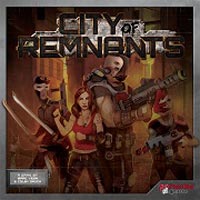
City of Remnants
Overview
In City of Remnants, players take on the role of gang leaders, vying for renown in a city controlled by a powerful alien race called the Yugai. Players will recruit gang members, build and control developments to acquire more recourses as well as attack other gangs in an effort to control more developments and gain even more renown. Every round the Yugai will also randomly patrol the city and players must decide whether to attack them or pay them off. City of Remnants combines many fun and strategic gameplay mechanics together in a very fresh way to make for a game that you’ll bring out again and again.
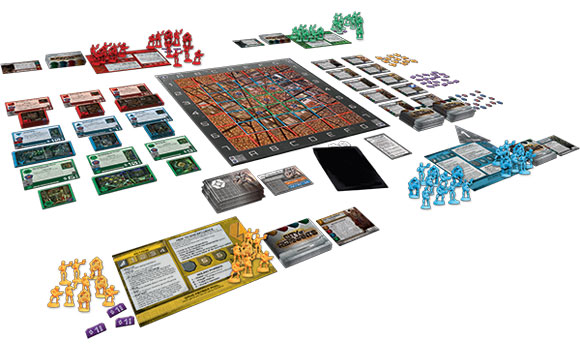
Set Up
Rather than give a specific overview of how to set the game up, we want to focus on the elements that make the gameplay unique each time you play! (For a detailed overview we recommend checking out Plaid Hat Games’ how-to-play video in the videos tab or on their site)
First off, there are four different gangs that players can choose from, each with different strengths, weaknesses and play styles. You can either let players choose which gang they want, or draw from them randomly. In general, the red and green gangs have an emphasis on fighting, and the blue and yellow gangs are more about money and development. For example, if you’re playing in a three-player game as the yellow gang, and your opponents are green and red, make sure to increase your defenses!
During setup you’ll also randomly choose three developments (out of six) for each of the three development types that will be purchasable throughout the game. Each development has its own set of special rules that players can take advantage of when they control that development.

Combine the unique play styles of each gang with randomly selected developments that have their own unique abilities and you’ve got a recipe for endless replayability and fun!
Gameplay
Influence
Before we dig in, it’s important to talk about the Influence each player has. At the start of the game each player has four Influence. Influence determines how many cards you draw up to for your hand, how many of your gang members you can control during the Move action, how many cards you can play during a battle, and also how much product you can sell. Obviously the more the better in all cases!

Players can have up to seven Influence. In a nod towards video games, you gain Influence by accomplishing achievements. There are five different achievements, so your options are a bit more open, and you can blend the achievements you’re working towards with your play style and the play style of the gang you’re playing. It’s a fresh and fun approach that gives you mini-missions to work towards as you play through the game.
Player Deck
Each player has their own starting deck (10 cards) that is specific to the gang they are playing. Each starting deck is different, but they all contain unit cards and ability cards. The areas to pay attention to are the colored numbers on the left (your attack value), and the card actions in the middle.

To add more cards to your deck you can bid for gang member cards and buy black market cards. This is when you’ll really want to pay attention to the attack value numbers, because you can only use the attack value number that matches your gang color. In general, you’ll rarely acquire a ton of cards, so you’ll be going through your deck a lot during the game.

Gameplay happens over a series of rounds. Each round includes four Phases:
1-Reset
2-Player Turns
3-Yugai Patrol
4-Award Renown
Player Turns Phase
The bulk of the action happens during this phase. Each player gets 4 turns, and during a turn you can perform one action:
- Recruit: Bid for a new gang member card
- Move: Move your gang members figures and resolve attacks
- Production >>> Develop: Developments you control will produce products, and you can buy and place one new development on the board
- Buy: Buy a card from the black market and/or buy renown
- Sell: Sell the products that the developments you control have produced
- Refresh: Discard unwanted cards and draw up to your hand size
There’s a lot to choose from, and the beauty of City of Remnants is there are many ways to go about gaining Renown so you’re not forced into a set strategy. Instead of breaking each one down, we’re just going to talk about movement and production.
Movement Action: You get to move a number of your gang members equal to your influence up to 3 spaces.
Placement is very important, both for offense and defense. You can only have two of your gang members on the same space, but gang members that are adjacent to each other (orthogonally) will act as support during battles. Battles don’t occur until after you’ve moved each gang member, so you’ll have the opportunity to set things up for the ideal attack or the ideal defense. If you end your movement action with one or more gang members on a space that contains an opponent’s gang member(s), a battle begins, and doesn’t end until either the attacker or defender is the last one standing.
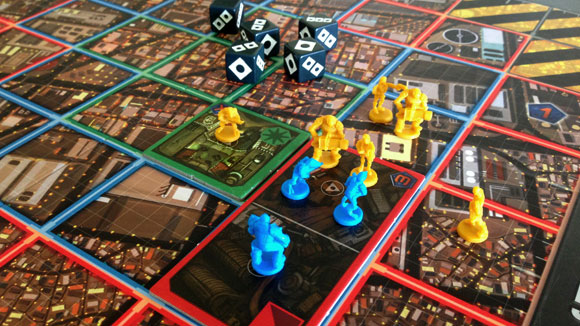
Battles are a combination of playing cards from your hand, your draw pile, and rolling attack dice. Both the attacker and defender can lay down a number of cards to use in battle up to their influence. If you don’t want to use all the cards from your hand, you can simply draw from the top of your deck, you just can’t look at what you draw until you’re done laying down your battle cards.
The attacker then reveals his/her cards and notes any battle actions on the cards that apply. Then the defender reveals their cards. Then both players roll a number of battle dice equal to their gang members in the battle space and adjacent to that space. The attack value is added to the dice roll, and the highest attack value wins. The defender wins on a tie.
Battles are a ton of fun, especially since they are a mix of known and unknown elements. Do you play the good cards in your hand, or do you gamble and draw from your deck to try for that great battle card?
Production >>> Develop Action: There are a few spaces on the board that automatically give Renown if you control them, but it’s buying and controlling developments that can really increase how much Renown you’ll get. Developments are also the most effective ways you can gain money. Pay extra attention to developments that give other types of advantages like extra dice during battles, chances to recruit mercenaries for free each round, extra defense, etc.
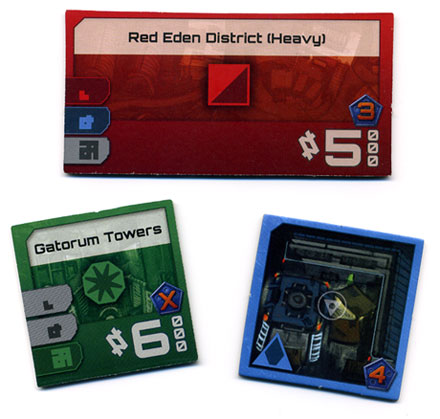
Developments have colors in the lower left of the card that indicate what color areas they can be placed in. The green cards, which have some of the best perks are also typically the ones you have to place towards the middle of the board… get ready to defend them!
Yugai Patrol Phase
To make things a bit more unstable, after the Player Turns Phase the first player will draw two YCU coordinate cards, randomly draw YCU tokens and place them on the board according to the coordinates on the cards. If one or more tokens ends up on a space with your gang members, then you must choose to either pay them off or attack them. Money can be tight, but there is no risk involved. If you choose to battle, you could lose, and even if you win, you roll an effect die that has a bad effects on a roll of 1-3 or good effects on a roll of 4-6.
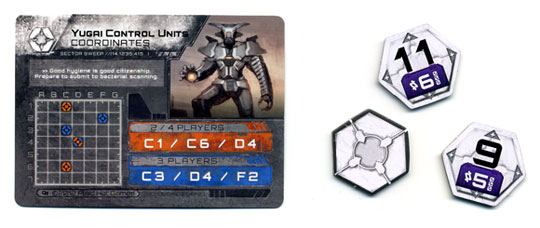
Award Renown Phase
This is when you look at all the renown spaces and developments you control and collect your renown.
In City of Remnants the ultimate goal is to gain the most Renown points. There are 200 points worth of Renown tokens. If there are still Renown tokens after this phase, play continues on to the Reset Phase where the first player token gets passed and players can discard and/or refresh their hand and draw deck.
Once the Renown tokens are depleted the game is over, and may the best gang leader win!
Components
The quality of the components is top notch. The design and art just oozes sci-fi in all the right ways. This game definitely takes up a good amount of room on the table, so be prepared for 5-10 minutes of setup time. They could have just included regular d6 for attack dice and one miniature sculpt to use for your gang members on the board, but Plaid Hat Games went above and beyond by creating custom attack dice and four different sculpts for your gang member figures. All of this combines to help you get lost (in a good way!) in the theme and gameplay.
Learning Curve
We watched the how-to-play video (26 minutes) and after that only had to refer to the rulebook twice! Teaching others to play is easy. It can seem a bit overwhelming at first with everything on the table, but after a couple turns players have the basics down, and then it’s just fun working on your own strategies to win.
Who would enjoy this game?
Final Thoughts
Like any game with intense conflict, the game has its emotional highs and lows depending on how well everyone handles defeat, and whether you enjoy direct conflict with other players. Because there are many ways to gain Renown, if battling isn’t your thing, you can focus on other strategies for the win, but make sure you’ve at least got your defenses up!
It’s also a great idea to play at least once as each of the four gangs, so you can get a sense of what strategies you enjoy the most, as well as knowing what you can expect from your opponents. One thing to note is that there is a possible infinite money loop if you’re playing the yellow gang and get the Communication Device cards. Plaid Hat Games has since released an FAQ on their support page which resolves the issue. In the end it’s a minor issue with a simple fix, so definitely check out the FAQ.
There is a great sense of progression through the game as you build up your resources. You’ll start out trying to maximize every action, and then later in the game things open wide as you begin to rake in the money and take more control of the city.
My biggest compliment to City of Remnants is that it’s fun and rewarding the entire time you play, whether you win or lose. The Influence achievements are genius. They give you goals to pursue as you build your gang, developments and resources. Because of that, even if you’re on the losing side of things, you’ll feel a sense of accomplishment as you hit each achievement.
City of Remnants is the right mix of gritty sci-fi theme with a fresh take on well loved and new gameplay mechanics. It has plenty of depth to the strategy, and we keep finding ourselves going back for more.
User Reviews (4)
Add a Review for "City of Remnants"
You must be logged in to add a review.



City of Remnants is a game about various humanoid races from around the galaxy whose planets have been conquered by a powerful race called the Yugai. The conquered races are gathered onto refugee planets where they inevitably form gangs in order to survive their harsh conditions.
City of Remnants plays from 2 to 4 players, where each player chooses one of four gangs to play as. Each gang consists of 10 basic cards that are specific to that gang, including a gang leader, some gang members and some ability cards. The gangs are asymmetrical, so each will play differently and require different play styles.
The Human gang (yellow cards) are able to recruit more gang members easier than other gangs and also can cycle through their deck faster.
The Nei’su gang (blue cards) allow players to get black market cards and developments easier.
The Lentree gang (green cards) allow you got get money easier.
The Iggaret gang (red cards) are mobile and the most aggressive fighters.
The game is played in over several rounds, with each round consisting of several phases. Players start out each round by having the option to reset their hand of cards. Then each player will take 1 turn each until each player has taken all 4 of their turns for that round. After the player turns have been taken, you have to determine where the Yuguai patrol tokens will be placed on the board and see if anyone has to fight or bribe them. Finally, renown is awarded to players who have their gang figures on certain spaces of the board, or from developments tiles that they control. That is a round and then starts over. The game is played until 200 renown have been collected by the players and there is no more to be collected. Renown is basically victory points received for doing or accomplishing various things during the game.
Player Turns:
Each time a player takes one of their allotted 4 turns, they can do one of several actions.
They can take a Recruit action in order to gain other gang members. This is done with an auction mechanic.
They can take a Buy action to purchase black market cards to help them in various ways, such as in battle or for gaining money or renown.
Take a produce/develop action to be able to have a development they control produce possible resources, and they also can buy new developments. Developments are buildings that can be factories, drug producing buildings, casinos or protection facilities. They are generally illicit places that you can develop in order to produce things or provide services in order to gain you money and they also provide renown as well.
Players can take a Sell action in order to sell goods produced by their developments.
They can take a Refresh action in order to get rid of cards they don’t like in their hand and get some new ones, but you can only get up to the number of cards equal to your Influence level, which starts out at 4, but can be moved up to 7 through various means.
Finally, players can take a Move action. Players will have plastic minis in their color that represent their gang members. They start out with 7 of them on their player mat and can use Move actions to move them onto the board and into their starting areas. From there, they can move to claim spaces for renown, secure spaces for future development, or move into enemy held space to start a battle. But you can only have up to 2 of your figures on any one space at the end of your move.
When players’ figures end their move in a space with an enemy figure (which includes the Yugai patrol tokens) they will battle. When in a battle, the attacker and defender will choose cards up to the Influence number they have and play them face down. You can choose cards from your hand and/or top cards from your deck. Gang member cards will have battle values, as well as some battle boosts. You count the number of your figures in and adjacent to the enemy’s space where the battle is, and roll that many battle dice. You then add the number rolled to the total of battle value on the cards you played. The higher value wins and the loser must remove one figure from that battle square and also remove one card that was played in that battle from the game, as it represents a lost gang member. If there are still enemy figures left in the same space, you repeat the battle procedure.
Yugai Patrol Phase:
After all player turns have been taken and battles resolved, players move on to the Yugai Patrol phase where the starting player reveals 2 Yugai Patrol coordinate cards that show where the Yugai tokens will be placed on the board. Then that player retrieves the appropriate number of tokens from a cloth bag and then places them on the board based on the coordinates provided by the 2 cards. If any of those tokens are placed in the same space as any player’s gang figure, then that player will do battle with the Yugai. The token will have a battle value you have to reach equal or greater to in order to defeat it, but it also has a bribe value that is a cost that it will take to bribe the patrol instead of fighting it. After defeating a patrol, you roll a die and check on a chart to see if you gained renown, money or lost renown or money. So sometimes it’s rewarding to win and sometimes it’s not, but either way, it might be better than losing gang members in a battle. Some players may choose to move into a patrol token space on their turn to purposely engage with the patrol in order to hopefully gain renown or money.
Winning The Game:
Play continues until a player would receive renown, but there are no more tokens to take from the supply . At that point, players will count up what renown they would have gotten for that round and add it to the renown value that they have in tokens, then the game is over and the player with the higher total renown is the winner.
Impressions:
The rules are pretty easy for this game, but despite that, there are a lot of things going on. Players will have lots of options during their turn. There is an economic aspect of the game with city building and production, there is an auction element used for recruiting, and there is certainly a conflict element when battling other gangs, or even just the Yugai patrols.
The game box says it takes 60-90 minutes, but that must be with 2 players on the low end of that and 4 players on the high end of that, who have played it enough times to be quite familiar with it. It will take close to 3 hours +/- for players that are just starting out. The main thing that takes time is in learning all the different cards that are available. You have your own starting gang cards, but also have to learn the new gang member cards as they become available each round to recruit. You have to learn the black market cards that come up each round. You have to learn the building/development cards that are available during the game. And finally, you can have a few or a lot of battles depending on where the Yugai patrol tokens get placed, and how aggressive players play against each other.
I think it’s a pretty cool game, as long as players are prepared for the time required and allow for it. The rules are pretty straight forward, but players will have plenty of options as far as what they want to do in order to gain renown. You will need to develop buildings, but you can also try to take another player’s building that produces goods and gives renown. You can try to battle the Yugai in order to gain money and or renown, but it’s a risky venture. Likewise, you can try to occupy certain spaces on the board to gain renown.
Pretty much the only thing that can be an issue to me is the length of the game, but if you go into it as if going into a game like A Game of Thrones or similarly lengthy games of battle and area control, then it shouldn’t be an issue.
The game certainly is the type that can get expansions, with new gangs, new gang member cards, new black market cards and new development tiles. So there are possible means to get even more out of this game system.
Your homeworld has been destroyed and you have been sold as a slave, living among what little remains of your species. You now live on an unfamiliar alien world overrun with Yugai, an alien race*bent on capturing all that remains of the universe. Do you have what it takes to rise up? To take back the planet? Welcome to City of Remnants by Plaid Hat Games.
In City of Remnants you play as one of four gangs who are out to gain renown and take over the underdwellings of the planet. To gain control you must buy and produce developments including weapons factories, prostitution dens, and slave traders. Choosing your gang can be a little tough because each gang plays completely different. Each gang comes with a deck of ten unique cards. As you play, your deck will be getting larger so it is wise to spend money on units early in the game. Just be mindful though, because a unit’s usefulness depends on the color of your gang. The yellow player, for example, is great at accumulating cards and cycling through the deck quickly. The green player is more of a defensive player and the red player can easily dominate the board by force. This shouldn’t stop you from trying a strategy of your own though. There are many ways to win besides following your gang’s suggested playstyle.
Along your path to power and escaping slavery you will encounter rival gangs, along with the Yugai themselves. How you build your gang and empire is completely up to you. Each other player will be trying to attack you and steal your developments. It’s a game of bluffing and risk when it comes to dealing with your foes.
City of Remnants is played in rounds. At the beginning of each round, players reconstruct their hands and then are given money to spend. From here, players take turns completing actions including recruiting gang members, buying developments, producing goods which can be sold for cash, moving on the board, and buying black market items. Picking your actions is a chore in itself. Each player gets four actions a turn in preparation for enemy attacks. Unfortunately, other players are not your only enemies. No, every round a player must draw two Yugai coordinate cards and then place Yugai units on the map. If you are in a space where the aliens land, you must fight them or bribe them. Bribing them is easy, but fighting can be a real pain. Even if you do amass a high enough attack to defeat them, you then must roll a die to resolve the conflict. Roll a three or below and something bad happens, such as losing credits or having to draw a new coordinate card. Roll a four or higher and you could land yourself a big reward like more renown.
After fighting the aliens, players receive renown for any developments they control, and a new round begins. The game ends when the pile of renown has been depleted. At first this may seem like the game would take forever, but as players start controlling more developments and begin to buy renown, the game starts to quicken. The recommended time on the box says between 60-90 minutes, but you can expect at least a two hour game for your first time playing through as you get used to the mechanics.
The first thing you will notice when opening the box is that the game comes with a lot of pieces. You will be using most of these pieces, so a large table is recommended as a play space. Each gang comes with plastic figures, a gang mat, and their own deck of cards. Each game you will play a random set of developments, so the replayability is quite high. The game is of sturdy construction and there are more plastic bags inside the box than you’ll know what to do with.
What makes City of Remnants so great is that it takes a lot of mechanics from other games and improves upon. You’ve got elements of deckbuilding, gambling, bluffing, and tactical warfare. I would compare it to a mix of Small World, Epic Duels, and Dominion. While this game may be a little dark for kids, it’s a great game for you and 2-3 of your buddies. I can’t recommend this game highly enough
I have played City of Remnants only once, after much anticipation, having read and watched many preview articles and videos. I was disappointed by the gameplay in several key areas:
Gang Members
A core mechanic of the game involves the recruitment and utilization of various gang members, each of which offers differing strengths and weaknesses dependent upon which color player you are. The manner of recruitment provides an interesting approach, whereby a member may be recruited for free if no one bids against the current player, or the player can be outbid, losing the intended gang member, yet costing the out-of-turn player one his actions per turn.
The gang members themselves, however, are less impressive. There is not as much variety or uniqueness as I had expected, and the cards that stand out as must-haves are obviously so, whether to get them into your own gang for their benefits, or merely to keep them out of the hands of the more color-suited player.
I would have been more pleased with each gang member being a unique individual within the city, but, alas, there are only a few “named” individuals and a handful of duplicated roles.
Yugai Patrols
Another core element of the game is the Yugai, the alien enforces that have imprisoned and enslaved the players and gang members within the city. These aliens patrol the city throughout the game, posing unexpected raids and assaults, lest they be bought off with well-placed bribes.
I found the Yugai element to be weak. After the first round or two, when placing the Yugai patrol tokens bespoke of impending doom, that part of gameplay became tedious. Putting the tokens in the bag, pulling the tokens out of the bag. The repetition of the chore outweighed any sense of threat imparted by their presence. In fact, the Yugai patrols, though often posing an obstacle, never seemed to pose a true threat. There was no sense of needing to avoid them, as the patrols were random and often no where near where the player gangs are competing. In but a few cases, the patrols were easily dispatched or bribed, causing only minor inconvenience.
I would have preferred a more thematic experience of always being on the edge, covering ones tracks. A less random approach would have, perhaps, been better… knowing where they are, but that they are coming.
Perma-Death
This is the main mechanic of the game that appealed to me the most, and one that I actually enjoyed during gameplay: the permanent death of gang members when killed, forcing the discard of the recruit’s card from the game rather than to a discard pile. Though the mechanic worked at a fundamental level, my overall experience suggests an overall flaw in the game experience.
The game I played was only 2-player, and by the end we had recruited all available gang members and had begun to exhaust our hands of viable members through combat and attrition. I find it hard to imagine them lasting long in a 3- or 4-player game.
I reviewed this puzzlement afterwards and came across an article by the designer (or publisher) that basically said that if you focused too much on combat, you weren’t “getting the point of the game”.
Final Thoughts
Although intellectually I am still intrigued by the game and would like to play it a couple more times to test different strategies, I find that the single gameplay experience I have had has left no emotional desire to play the game again. I expect to at some future point, but have not found myself in any rush to do so.
I am hesitant to rate or judge the game based solely on this single gameplay, which would only grant it a so-so rating. I think I will approach it again with realised expectations and then try to judge whether it is, indeed, fun or not.
Overview: The game centers around 4 rival gangs in a prison world. They are fighting amongst themselves to control areas while building up their empire by constructing buildings. Also, each round there will be new gang members players can recruit and special equipment to purchase in a black market. This all adds a slight deck building mechanic which is unique to this style of game. At the end of each round, non-playable police will appear in the city which will need to be fought or bribed.
Replay Value: City of Remnants is another one of those games that I would want to play immediately after the first session. But unlike other games, where the pure joy of game play inspires me to play multiple consecutive games, the desire to run this one back is mostly because I want to play better/make fewer rookie mistakes in the second game.
Component Quality: the cards, tokens, minis, and map were all of decent/high quality.
Conclusion: While I’d like the game I wouldn’t recommend running out to buy City of Remnants unless your gaming group is more hardcore.